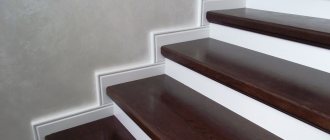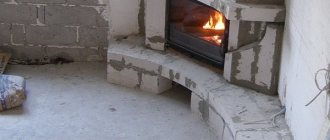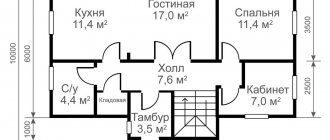Paved paths are gaining popularity among summer residents. This is not surprising, because the material is durable, does not wear out, and is suitable for regions with different climatic conditions. The installation technology does not cause any difficulties, so it can be done by owners without any knowledge of construction. You just need to follow the recommendations of the masters.
Garden paths made of tiles will add uniqueness, practicality and neatness to the landscape of your yard.
Required tools and materials
When the issue of the location of the future path has been resolved, it is worth preparing the necessary materials and tools.
Photo: checking the horizon using a level
These should include:
- wooden pegs and rope (for marking);
- rubber mallet (mallet);
- rake;
- watering hose with sprayer;
- Master OK;
- shovel;
- building level;
- roulette;
- grinder and diamond-coated disk (for cutting tiles);
- manual rammer;
Photo: manual tamping - sand;
- crushed stone;
- geotextiles (for moving soils);
- cement grade no less than M400–500.
In addition, it is important to ensure the possibility of unhindered connection to electricity and water supply. It is better to work in rubberized pants or knee pads and mittens.
You need to remember that tiles are sold by square meters, and borders are sold individually. To calculate the number of the latter yourself, you need to multiply the length of the path by two and divide by the length of one curb.
And knowing the approximate price of the coating, you can calculate the average construction costs. So, it is worth adding another 20% to the amount of expenses for tiles, taking into account possible damage and trimming of products.
Criterias of choice
When choosing a suitable material, you first need to focus on its cost. High-quality tiles that will last for several decades are made mainly from natural raw materials and have a relatively high price. The following types of raw materials are most often used in the manufacture of finishing materials:
- hard and soft varieties of natural stone;
- fake diamond;
- polymer sand mixtures;
- concrete mixtures;
- firing materials.
An additional criterion for choosing a finishing material is the thickness of the tile. To design, for example, narrow paths, it is quite possible to choose a material whose thickness does not exceed 0.4 - 0.6 cm. If you are laying a road or parking lot, you need to choose especially durable tiles, the thickness of which varies over 0.8 cm.
Tiles made from a mixture of concrete Source plitkaoskol.ru
Preparatory work
Schematic arrangement of layers
At this stage, the procedure is as follows:
- Along the edges of the future garden path, pegs are driven from paving slabs, to which a rope is attached at a height of 7 cm, and then a rope is pulled.
- The area is cleared of vegetation, tree roots, and stones.
- The territory is leveled, so soil from the hills is removed and poured into holes, if any.
- The surface is smoothed with a rake and compacted.
- The height of the base is calculated taking into account 2–3 cm of shrinkage. To create a sand cushion and lay tiles, 30 cm is enough.
- It is recommended to lay geotextile flooring to prevent the formation of excess moisture and the growth of weeds.
- A layer of crushed stone or sand is poured. It serves as a drainage system for the path.
- The sand is evenly distributed over the area with a rake. Moisturizes well with water.
- After a few hours, the pillow is given a smooth shape so that you can begin laying.
Photo: checking the horizontal plane of compacted sand
If you need to arrange communications, then this should be done precisely at the stage of preparing the foundation.
For pedestrian paths, a sand cushion 10 cm high will be sufficient; for the roadway, the layer increases to 20 cm.
Reinforcing the edges of the path with curbs
Masters advise not to forget that the base is created approximately 25 cm wider than the future area of the masonry. After all, curbs are also installed on the sides - elements that protect the coating from deformation and spreading.
Installation of parts of a heavy structure is carried out before laying the tiles, deepening them into the ground, and of light ones - after completion, securing them with crushed stones on both sides.
Photo: installation of curbs completed
Borders should only be placed on a level base. For structural reliability, it is better to do this on top of M100 liquid concrete mortar. It can be level with the tiles or slightly higher.
Builders advise taking shrinkage into account, so the pavement must be laid at least 5 mm above the curb.
Is it necessary to make an incline?
Yes, this is a mandatory measure so that water can flow away from buildings and not towards them. Depending on the location of the path, the slope is made:
- longitudinal;
- transverse;
- longitudinal-transverse.
It is considered optimal to install a covering with a slope of 5 mm for each meter of sidewalk.
Rules for constructing paving stone paths
Knowing some aspects will help make a comfortable and durable design.
- The width of the path for people to move varies from 0.6 to 1.5 m . The optimal size that allows you to disperse when meeting is at least 0.9 m. A structure with a width exceeding 1.2 m will be comfortable for pedestrians.
- Curbs should be installed on the sides, preventing the path from deforming and preventing the appearance of dirt during rainstorms.
Curbs should be installed on the sides - The path should be away from trees . This is important so that their root system cannot destroy the coating. Usually it is enough to maintain 2 meters.
- When choosing the type of substrate for paving stones, it is necessary to take into account the type of soil, purpose of the coating, characteristics of the material being laid.
What types of substrates are there?
Step-by-step description of DIY installation
Although creating paths from paving stones and other types of paving should not cause difficulties, let’s take a closer look at the main stages of construction.
Trimming
To do this, you will need a grinder with a diamond-coated disc. You should put on safety glasses and a mask in advance to prevent dust from getting into your eyes and lungs.
Trimming is necessary for maximum tight joining of elements. It must be accurate, otherwise you will end up with a large number of broken or broken tiles. The optimal incision size is in the middle.
To avoid wasting material, you should first mark the width of the path and approximately apply one row. With the formation of decorative patterns, everything is more complicated: their placement is marked with dots on the sand.
Installation of paving slabs depending on the type of base
The material can be laid on sand or cement-sand concrete mortar.
Let's take a closer look at both options.
On the sand
The easiest way. The distance between stretched ropes or already installed curbs is filled with a sand cushion to a height of 6 cm and moistened generously. When it dries a little, it is leveled with a rake and then compacted. The tiles are laid on wet sand. The cord is pulled tight. The first row should be created strictly according to its level. You need to walk in the direction away from the curb.
Photo: to avoid splitting the tiles, use a rubber mallet
To ensure that the width of the seams between the plates is the same, it is worth using special crosses.
For cement-sand mixture, concrete
The procedure is as follows:
- A dry mixture of sand and cement is prepared in a ratio of 3:1.
- Spread in an even layer on the base.
- If the site is on moving soil, it is recommended to add concrete.
- After moistening the mixture, you can begin laying.
If the tiles are not laid level, they need to be removed, sand added underneath or the excess removed. Compact each element with a mallet.
It is not recommended to install the coating on clean concrete mortar. It does not allow water to pass through, and with temperature changes, the path will begin to deform.
Styling design
Every owner wants to furnish his dacha or cottage complex in an original way. Creating garden paths with patterns is one of the elements of a unique landscape design. But this is painstaking work that requires knowledge of the intricacies of masonry, experience and patience.
Therefore, if you have the financial means, it is better to enlist the help of specialists. They will be able to create a neat turnkey coating.
Various installation schemes
If you decide to decorate the path with patterns yourself, then the photo above shows the most popular design options. A simplified method is straight-line masonry. It is better to install elements diagonally, this will make it easier to maintain an even horizontal line.
When laying in a circular pattern, you should purchase paving stones of the appropriate shape, and start work from the center of the pattern.
When creating mosaics from curved parts, you should stock up on sand. Since the distance between the elements will be much greater than with conventional masonry.
Grouting joints
At the next stage, you need to start filling the seams between the parts of the tile covering. A small layer of sand or a cement-sand mixture (depending on the type of base) is poured on top and distributed with a brush into the gaps between the elements. The path is moistened with water from a watering hose.
Photo: the process of grouting paving stones
Strengthening the path
To extend the life of the alley, it is recommended to compact the tiles after filling the joints. This can be done by walking over it with a vibrating plate weighing up to 100 kg. This measure will finally eliminate the discrepancies in height.
If you see that even a small part of the sand has fallen through, you should add the required amount into the gaps.
Arrangement of steps
It is recommended to build steps in the area of the yard where the slope exceeds 20 degrees.
This part of the path or porch is quite difficult to construct due to the work on a hill and the need to install retaining walls. The main thing here is the convenience and safety of walking.
Suitable materials:
- paving stones;
- slabs;
- concrete mortar covered with tiles.
But it is much easier to buy ready-made stepped elements, which are laid according to the same principle as paving stones. Do not forget about creating a reliable layer of waterproofing so that in severe frosts the coating does not begin to deform. The decoration of the sloped area will be lanterns installed on the sides.
What are the benefits of concrete paving stones?
It is no coincidence that the products are actively used for paving paths and constructing parking lots. This is due to their excellent performance characteristics:
- high strength and wear resistance, allowing to withstand the constant movement of a large number of people and vehicles (even trucks);
- resistance to the external environment: sunlight, temperature changes, precipitation and wind;
- durability;
- environmental safety.
Concrete paving slabs
The material can be reused many times. Unlike asphalt, paving stones do not react to heat. And for its use in regions with cold climates, special additives are added to the composition to increase frost resistance.
In addition to functionality, the material also has decent aesthetic characteristics, allowing you to create not only a practical, but also an externally attractive coating. What is very convenient is that you can lay paving stones yourself, without resorting to the services of specialists. It is important to decide on the design in advance.
Paving slabs “Roman beech”
Paving options
- When placing products in the direction of movement, the path looks dynamic.
- Laying the slabs crosswise creates the impression of staticity and solidity.
- Decorative paving looks very aesthetically pleasing, in which the tiles are arranged in a circle or in a herringbone pattern.
A diagram of the installation of paving stones is shown in the photo.
Layout of paving stones
Recommendations for caring for the coating
They are quite simple:
- The path must be swept regularly and promptly cleared of debris and sand.
- In case of serious contamination, oil stains, wash with water from a hose.
- Remove snow with shovels made of any material other than metal - it spoils the integrity of the coating. You should not sprinkle salt on an icy tile; it destroys the product and forms a coating on it.
- Swelling areas of the path can be easily repaired. Therefore, it is easy to remove individual tiles, level the base and put them in place.
- To protect against moisture, you can purchase a water repellent solution.
It is worth considering that a pavement made by vibration compaction will last 100 years or more. But vibration-cast products wear out much faster and last much less.
Photo: multi-colored paving stones
Current operation
- In winter, the surface can be sprinkled with sand to reduce slipping.
- To avoid surface erosion, it is not recommended to sprinkle paths with abrasive mixtures containing salt.
- It is not recommended to clean road surfaces in winter using tools with a metal working part (crowbars, shovels) .
- If the snow was not removed on time and ice formed, under no circumstances should you remove the ice using a metal tool.
- Caring for paving requires minimal effort.
- The tiles must be washed with water as they become dirty, more often in high-traffic areas. Cleaning a small area of paving near the cottage is not very difficult.
The best manufacturers
Let's take a closer look at 5 well-known manufacturers in the CIS countries that have proven themselves with high-quality products and affordable prices.
"Siyan"
Russian paving slab factory. Each view is fully painted over. Therefore, when worn out, the products do not lose the integrity of the color coating. SIYAN produces tiles of various shapes and thicknesses. It is suitable for laying garden paths, driveways, and highways. Prices are available. The products are durable and reliable.
"Unigran"
A Ukrainian manufacturer that has its own raw material base, from which it produces wall blocks, tiles, and borders. All products are certified by the ISO 9001:2015 quality control system.
Paving, ceramic coating is created using vibrocompression technology. The company offers more than 30 types of goods. All tiles are frost-resistant, with a service life of 50 years.
"Stellard"
The company and production are located in Russia. The products are manufactured using the method of semi-dry vibrocompression. German equipment is used to create tiles. The plant carries out individual orders for the production of tiles of various shapes and colors. The work of the workshops is automated.
Stellard products are a worthy replacement for old road or garden surfaces.
"White Hills"
A Russian enterprise that has been specializing in the production of facing bricks, stone, tiles, paving slabs and related decorative elements for more than 10 years. With a wide selection of textures, shapes, colors. The paving stones they produce are very popular, imitating natural stone such as gabbro and diabase.
"Steingot"
A relatively young Russian enterprise. It was founded in 2015. Engaged in the production of paving slabs and facing materials. The workshops are equipped with modern German equipment. The production process is automated. The main consumer market is Moscow and surrounding regions.
Whatever manufacturer you choose, a garden covering decorated with paving slabs will be a profitable, convenient, and most importantly, durable option for arranging a summer cottage. Construction is easy to do yourself. And if you want to post entire drawings, you can invite specialists to help you who will bring your ideas to life.
Types of paving slabs with their pros and cons
Modern manufacturers of building materials produce paving stones using various modern technologies. Depending on the characteristics of the technological process, sidewalk tiles are divided into 3 types:
- vibration-cast;
- vibropressed.
Vibrocast tiles are produced using plastic compounds . The “filling” of the building material is poured using equipment into special containers – “vibroforms”. Paving slabs of this type have an attractive appearance; they imitate natural wood or brick. Most often, this type of building material is used for individual construction. Vibro-cast tile elements are used for arranging personal plots of country houses and cottages. They are also laid out on paths located in parks and garden plots.
Vibropressed tiles are made in a different way. The pre-prepared concrete mixture is poured into a special mold. After this, it is subjected to pressure, which is created by special equipment - a brick press. Thanks to a special manufacturing technology, the building material has a strict shape with a rough surface. Vibropressed tiles are used to lay sidewalks, pavements, squares and roads in crowded and public places.
Read on topic: Construction of high-speed highways
Modern consumers have access to a large number of product options in a variety of colors. Paving slabs also come in various shapes; the most popular are the following shaped paving elements:
- honeycomb;
- paving stones;
- scales;
- clover;
- wave;
- fleece;
- gzhelka;
- flower.
Depending on the material from which paving slabs are made, they are divided into several types. Relatively inexpensive building materials made of concrete and clay are popular among modern consumers. In the arrangement of suburban areas, clay paving slabs imitating roofing tiles are often used. To improve the technical characteristics of the building material, manufacturers can add a binder material, for example, granite chips, to the tiles.
The most wear-resistant are granite tiles , characterized by the excellent strength characteristics of natural stone. It easily tolerates sudden temperature changes, due to which it has a long service life. Concrete slabs become unusable after 3-4 years, asphalt pavement will begin to deform after 2 years, and granite tiles will last more than 25 years. Another plus of granite is that it does not require additional means of protection against damage. The disadvantage of natural building materials is their high cost.
Installation of curbs
The next stage of installation work will be the installation of concrete or plastic curbs. Absolutely any type of material can be used as an enclosing element. If the landscape design is made in a classic style, then the best solution would be to choose concrete elements. For design in the Provence style, it would be most appropriate to use wood and crushed brick.
On average, the width of such an element is from 10 to 15 cm. Concrete curbs are fixed immediately on top of the drainage system. To prevent them from moving during operation, they are connected to each other using a concrete composition. The construction mixture is poured into the voids and leveled with a construction trowel. If there is free space left behind the concrete product, then it must be filled gradually. In this way, it will be possible to prevent the appearance of air voids in the structure.
How to make drainage?
The bottom of the trench is pre-compacted on top of the geotextile. After this, a backfill of fine crushed stone is carried out; the thickness of such a layer should be 15 cm. In this way, it is possible to create good drainage for the rapid drainage of ground and surface water. In winter, it is possible to prevent soil freezing.
Before laying the tiles, pour a thin layer of sand onto the pebble layer. This type of material allows you to achieve an ideal flat plane for installing concrete elements.
Luminous pavement tiles
If you consider yourself to be an extravagant person and love creativity in everything, you will undoubtedly be interested in luminous paving material, the so-called lyubmobeton. Its glow-in-the-dark time is 8-10 hours. On sunny days, it is “charged” with the energy of sunlight (electric lighting is also suitable for this) and after dark it begins to glow.
This material will turn your site into an extraordinary, exclusive corner that all guests of your home will admire. Such tiles resemble a lunar path that everyone would like to walk along. The material produces the greatest effect in the first hours after dark.











